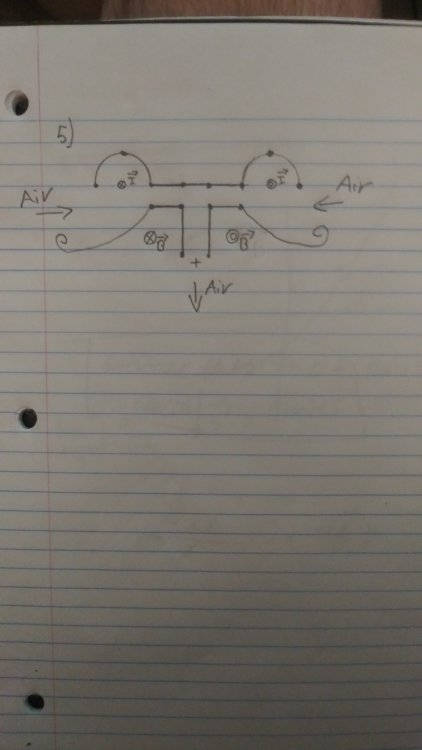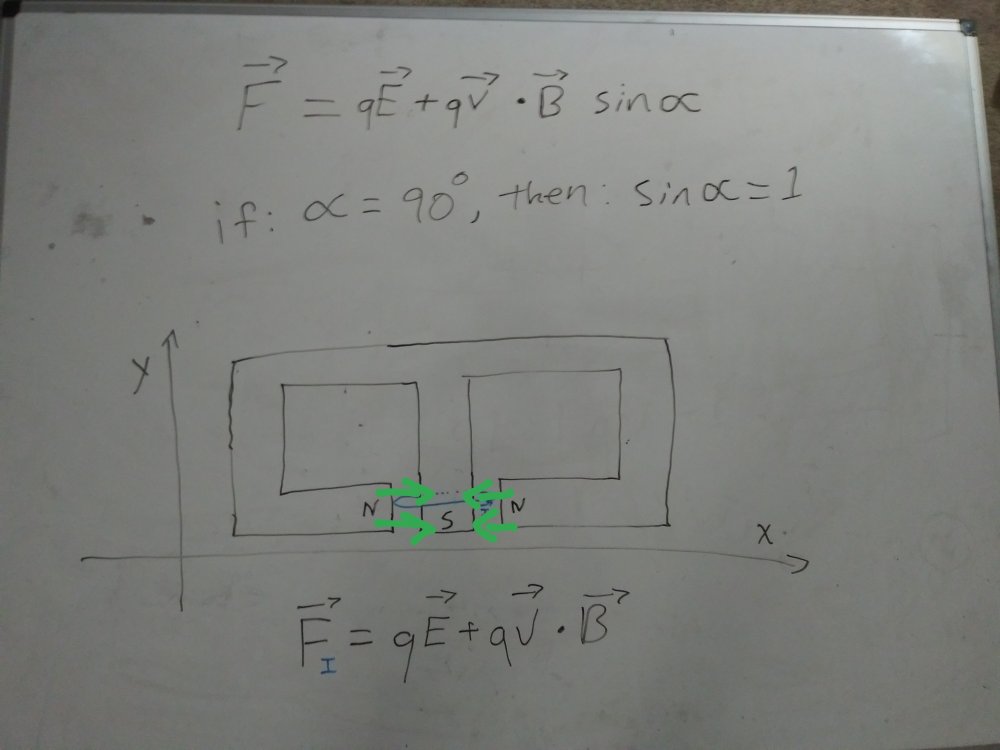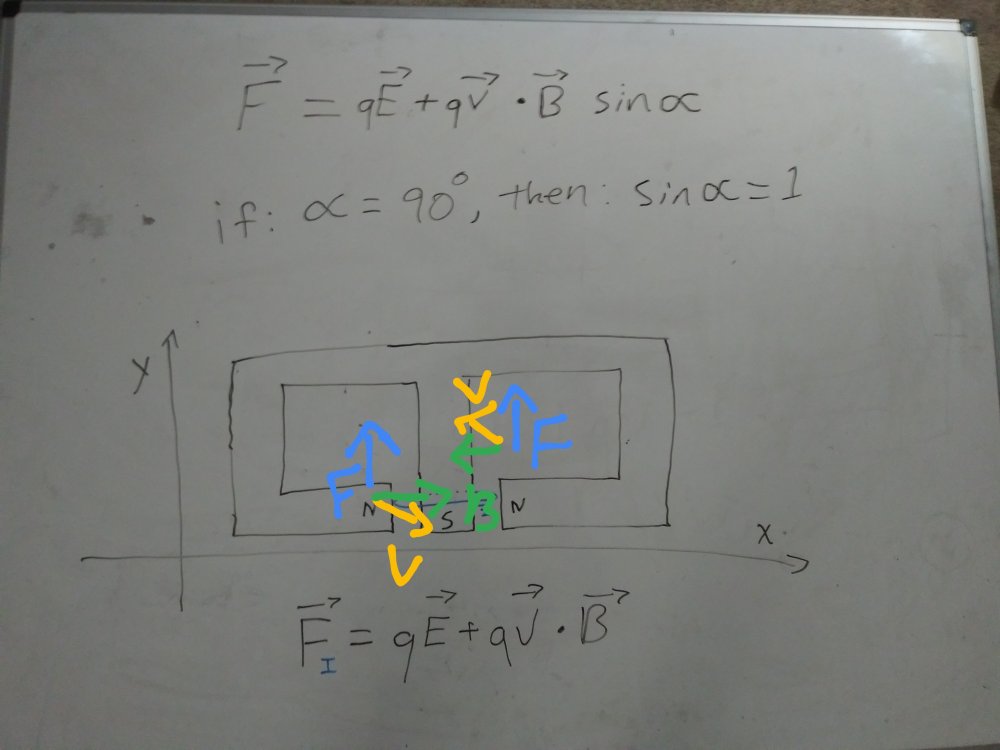

DandelionTheory
Senior Members-
Posts
225 -
Joined
-
Last visited
Content Type
Profiles
Forums
Events
Everything posted by DandelionTheory
-
You're correct I misspelled it. I'm asserting the electron will not contribute to the Laplace force when it is not in a wire.
-
Now you're getting it. It does, the wire goes in one direction and the electron in the other. All charge carriers experience the lorentz force, only ones in the wire contribute to drag in the laplas force on the wires. The free electron in the arc still does work on the other electrons in the wire and vice versa, the free electron in the arc just does not contribute to the drag part of the laplas force calculation on the structure.
-

Lorentz force at right angles.
DandelionTheory replied to DandelionTheory's topic in Classical Physics
Dielectric breakdown in the 30kv/in range, it's in the math. I did not mention the math involved for dielectric breakdown, but at a potential difference of 30kv with an air gap of 1in the wiki says that's about as far as you need to get a spark in air at 1 atm and no turbulence. Assuming the term "range" I just used satisfies the idea more potential would need to be compensated for turbulence in the air gap. So I set it to 45kv. How fast could it charge the air would be a more appropriate question, and the speed of rotation in the cycle depends on the strength of the uniform B field into or out of the paper. -

poles of an electromagnet question
DandelionTheory replied to DandelionTheory's topic in Speculations
Never said it wasn't opposite, I'm framing a picture of a force. You assume other things affect this force, cool, I want to not look at that hole you put your mind in for a minute and maybe explore weird things we see. Is it incorrect because you see conflicting forces? that's not what I'm pointing out genius. The fact that you cannot comprehend a basic ass idea like this without interception of opposing ideas makes you incapable of seeing solutions to specific problems. "Checking people's work" is only beneficial to you if you know what you're correcting and you do it correctly, you are not in a patent office. Mansplaining the lorentz force makes you look stupid due to the fact that I've been trying to get you to reference it for a few weeks and you asked if it was a dot product. I know it, my slight of hand in notation shouldn't phase a someone who knows the equations. If you don't know what I'm talking about then don't respond. -
Never said it worked in a box. Again you refuse to read what was stated and assume im making something else. I've said it works by ejecting mass and laplas force's on the structure. I said momentum is lost when the arc is not attached to wires. Take a second and comprehend the idea child. I said it works in a vacuum. Not a box. Back up. We just had an issue with being on the same page. So you follow? Do I have some credit or are you attempting to "find some magic" I don't intend to claim? Can I be seen as someone trying? I told you how it puts force on the wires, I did not tell you it made enough thrust to push a car. I never had claims it did anything else. I said it was a circuit, I said it had wires, I said there was an arc to complete the circuit, I said the lorentz force calculates the total force on the current and the laplas force calculates the force on the wires. Do I need to tell you current creates a magnetic field around the wire... To which the magnetic fields I am calculating are originated; or can you grasp that?
-
Looks like drag. To be clear that's off the top of my head, I'll take a look at the laplas force's proofs a bit more. So the electron is connected to the atom and any charge carrier experiences force in a magnetic field, not it's own of course. So as the electron runs through the wire it takes a turn and hits space where some other electron's (from the same current) magnetic field intersects it's path, it will experience the lorentz force and the other electron will experience an opposite force. They both will drag on the wire. While the electron is outside the wire in the arc like mentioned before, no drag on the wire is calculated and therefore the laplas force does not apply to the structure but the lorentz force always applies to the electrons in or out of a wire.
-
https://physics.stackexchange.com/questions/378545/how-can-laplace-lorentz-force-move-objects-and-not-charges
-
My phrasing is wrong. I meant if the hypotenuse was attached it would add to the total force on the structure away from the center. Since it is not attached it still creates a magnetic field and still affects the rest of the "triangle" When current leaves the wires it cannot add to the momentum of them internally, just externally. It's a good thing.
-
Yes, more of an add-on to an idea of electron ejection. Ions are mass. More specifically current has mass.
-
Correct. Mass is ejected in the process I mentioned in the op. I attempted to show the completed circuit but y'all needed more clarification. So I broke it down. I'm sorry it does look like I'm trying to teach you something, but it seems like I'm just not understood the first time so I've been attempted to clarify. The completed circuit experiences force from the magnetic fields of the current in it. If some of the current is not attached to the wire loop, that momentum is not added to the total momentum of the wires. Agreed, but the ions are not attached to a structure during the arc. I tried and what I got back was "wrong" with no math or anything substantial to add but an opinion. I'm trying to explain. Some credit for the things I do get would help and not add to the discontent btw.
-
Is that before or after you understood it? The circuit is complete. I said it in the op. Attempting to make me insecure about what I've covered won't work. Never said there was no force on the arc, I said the ions would be outside the wire so it wouldn't matter to the total force on the structure. Due to them being not attached.
-
Your teaching methods need work. I gave you calculations where I showed force on the center wire from the parallel sides will cancel. Force on the top section does not. I go on later to state if the voltage was in the 30kv range and the air gap between the bottom parts of the circuit was 1 inch, the discharge would complete the circuit while losing some momentum outside the wire returning to ground as it finishes the arc. This is an assumption, but you wanted it to make a circuit.
- 68 replies
-
-1
-
Okay I guess I have to complete each circuit before force arguments are even considered. I could set up a resonant circuit that would satisfy this current setup. I don't see how that's an impossibility, or do I need to specify the calculation is for a snapshot? The first post claimed this chucked ions and the current in the wire experienced the lorentz force. It's not a tall order bro.
-

poles of an electromagnet question
DandelionTheory replied to DandelionTheory's topic in Speculations
So you are not familiar with the lorentz force? No. That's not the question. The question is If you didn't get "the current experiences a momentum change in the y direction" I can't help you. That's a loss in translation or something else. -
Cool, why? Show me some evidence why it's wrong please. It's condescending to demand clarification on an assumption of an assumption. I never said I claimed otherwise. Can you maybe get what I'm saying before it's assumed incorrect?
-

poles of an electromagnet question
DandelionTheory replied to DandelionTheory's topic in Speculations
So you just assume they apply to everything you think, and there is no way around any of it even with addition or cancelation. Cool that's not my problem. I'm learning buddy, could you teach me or do you just assume I'm trying to write a paper.... Because this isn't a scientific paper man. This is an idea to do a thing. Weather it applies to the whole I acknowledged that it doesn't account for force on the dipoles. Is it a lifter? Did I say it had mass or how much force or which way gravity was? No? Then how could it do what you said? You need to show your work or you don't have a standpoint. I'm trying to show mine, but you assume alot and it's insulting. Could you maybe give me something to look up because you say a bunch and complain a lot but I haven't seen your reasoning just claims. Could YOU draw a diagram? Reactions have a magnitude. So is my calculation on I true or not -

poles of an electromagnet question
DandelionTheory replied to DandelionTheory's topic in Speculations
I mean, you claimed there is no net force on the system. Is that because of the opposite force on the magnetic dipoles due to I? Because you can't assume. -

Lorentz force at right angles.
DandelionTheory replied to DandelionTheory's topic in Classical Physics
-

poles of an electromagnet question
DandelionTheory replied to DandelionTheory's topic in Speculations
Is this what you're referring to? -

poles of an electromagnet question
DandelionTheory replied to DandelionTheory's topic in Speculations
Because the B field is the same on both sides? No it's not. Look again. North to south. As the current rotates about the center axis the direction of the B field doesn't change. Did you rotate your hand with the current as it went around the south pole? Lol -
Do currents have to be attached to wires or is dielectric breakdown not a thing? You know if the electric field was in the 30kv range and the distance from E to C or D was 1 inch I'm sure some momentum would be lost in the discharge after the air breaks down. Wouldn't that be inline with conservation of momentum? Or you know, resonant frequency isn't a thing either right? Maybe little capacitors on the butt end of each wire could resonate a charge. But whatever I'm done trying.
-

poles of an electromagnet question
DandelionTheory replied to DandelionTheory's topic in Speculations
-

poles of an electromagnet question
DandelionTheory replied to DandelionTheory's topic in Speculations
The lorentz force is applied to a current sin theta to the magnetic field it's in, perpendicular to it's velocity. Period. Where did that not apply? I didn't account for forces on the dipoles -

Lorentz force at right angles.
DandelionTheory replied to DandelionTheory's topic in Classical Physics
I'm attempting to show the E field is towards the positive pole, which would depend on where the cycle is. If some parts are closed off while some opened up this would show how to move charged air from one place to another with low power. Sort of like a "charged air turbine". If you've seen the eye of horas the lash bit is usually lower to provide a Venturi effect to the left and be compressed out the right. Do you need a diagram? -

I need help with my math problem.
DandelionTheory replied to DandelionTheory's topic in Classical Physics
I simply state you can have the magnetic fields "hit each others tips" so they don't spin all the way around. It's because the B fields rotate about their axis to point toward the opposite sign and currents have a round magnetic field that make straight magnetic fields turn towards the opposite sign first before the center of gravity of the magnetic fields are affected.



